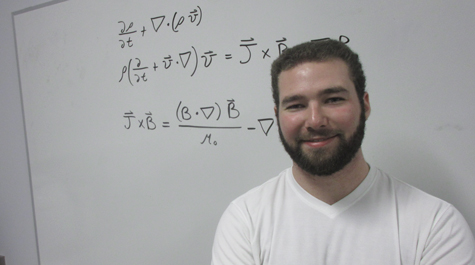Ryan Chaban: Grad student, ‘fusion guy’ and award-winning essayist
He’s a “fusion guy,” working with Assistant Professor Saskia Mordijck on some of the many knotty scientific problems that must be solved before we can tap the virtually limitless supply of energy that nuclear fusion can yield.
And Ryan Chaban is an award-winning essayist. His piece “Doublet Dudes: Shaping the Future of Fusion” won first prize in the inaugural History of Physics Essay Contest sponsored by the Forum on the History of Physics of the American Physical Society.
The APS website notes that the essay contest is designed “to promote interest in the history of physics among those not, or not yet, professionally engaged in the subject.” Chaban’s winning essay comes with a cash award of $1,000 and an invitation to speak at an upcoming APS event.
Chaban became aware of the contributions of the men he called the “Doublet Dudes” during his 2016 summer Science Undergraduate Laboratory Internship at General Atomics (GA) when his advisor, David Pace, won the Torkil Jensen Award.
“Everyone always talks about Torkil Jensen as if he’s the nicest, most brilliant guy ever,” Chaban said. “So I thought I’d do a paper on him.”
He spent a Summer Science Undergraduate Laboratory Internship at General Atomics and began researching Jensen’s work there. Chaban said he soon realized that the real story was Jensen’s partnership with Tihiro Ohkawa at General Atomics. His prize-winning essay explores the pair’s development of the “doublet” — a figure 8-shaped plasma that laid foundations for support for an advanced fusion program as well as a new generation of plasma physicists.
Chaban begins his essay by pointing out that the Doublet Dudes and other scientists working on fusion in the 1960s-80s did so “with the reluctant understanding that it will most likely not be achieved during their lifetimes.”
But Chaban is optimistic that he will be among the first set of physicists to work with sustainable fusion reactions. He explained that he begins his fusion career standing on the shoulders of Jensen, Okhawa and other members of the “reluctant understanding” generation of scientists who have laid the groundwork for fusion.
Scientists plan to produce fusion in devices called tokamaks, creating plasmas. Not to be confused with the blood fluid, fusion plasma is a separate state of matter, like a gas, but an ionized gas. Plasmas are common in nature. The sun is a plasma-producing fusion furnace. The Northern Lights are plasma.
Lightning also is a kind of plasma, but you don’t produce an artificial plasma in a flash. Scientists generate plasmas in devices known as tokomaks, keeping the plasma under control by magnetic fields. The goal, Chaban explained, is to produce a “burning plasma,” a self-sustaining fusion reaction that yields a “net gain,” with the device putting out more energy than is put in.
Chaban said that fusion science is approaching a state in which such results are realistic. He explained that ITER, the world’s largest fusion experiment based in France, is expected to start up its first plasma in 2025.
“I should get my Ph.D. in 2022. By 2036, we could see a net gain in fusion power,” he said. “Once we do that, it’ll be as big as the discovery of gravitational waves or the Higgs boson.”
The winning APS essay is a serious contribution to the history of science. Chaban didn’t limit his fact-gathering to the Internet or the library. He tracked down a number of fusion scientists to interview them about General Atomics back in the day.
“I interviewed, I think, three staff scientists and two or three retired scientists,” he said. All the interviews were conducted in the San Diego area, home to General Atomics (and Ryan Chaban.)
“All of them were really eager,” Chaban said. “Every single one wanted to share their experiences, especially with Torkil. Everybody loved Torkil.”
















